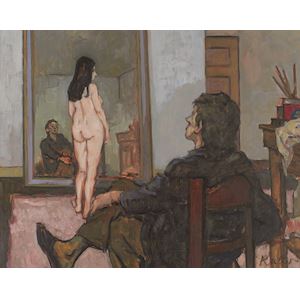
18 Zelfportret met model (Dichter bij Polak)
Nicolaas Baur, 1767-1820. Franeker Gate in Harlingen and Leeuwarder Gate in Franeker. More than 200 years ago, the painter Nicolaas Baur lived in Harlingen. He was a very precise painter and he was proud of his city. Look at the painting on the left. There you can see the rampart with the most beautiful city gate of Harlingen: the Franeker gate. The ramparts and the moat were intended to keep the enemy out of the city, and at ten o'clock in the evening the gate was locked. Nobody could get in then. But notice the foreground. Those swimmers are stark naked! And what is it they are climbing on? Logs. In the past, Harlingen traded a lot of wood and the wood was easier to work if it had been soaking in the water for a while. Look at the background. If you look closely, you can see a windmill. And now look at the painting next to it. That also is a city rampart. Sometimes Nicolaas went through the Franeker Gate to the city of Franeker and the little painting on the right shows the rampart of that city. On top of the rampart there is a flour mill. Why there? Today's windmills are very high to catch more wind. They also knew that back in 1800, so they built the mills on a high spot. And what do you see on board of the ship in the foreground? It looks like stones. But no, those are blocks of peat. Peat consists of compressed plant matter. For hundreds of years people used it to heat their homes. The skipper of the peat barge made sure this fuel got to the cities. If you look closely, you can see the onion-shaped roof of the Leeuwarderpoort in the background. Which city gate do you like best?


Die Museen Zutphen bestehen aus dem Städtischen Museum von Zutphen und dem Museum Henriette Polak und sind in dem Stadts-Palast "Jof van Heeckeren"des 17.Jahrhunderts undergebracht. Hier treffen sich Geschichte und Kultuurgeschichte, bildende Kunst und Aktualität auf überraschende Art und Weize
- 's Gravenhof 4
- Zutphen Netherlands
- 0575516878
- www.museazutphen.nl
